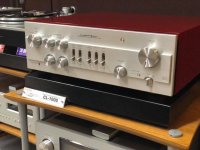Kingrex
Active member
Go to audiogon forms and look up the poster whiteCamaros. He has done extensive testing with the Luxman's. I know nothing about them and I'm not picking any sort of fight, but his take was the preamp and amp together can get a little dark. He has other preamps he's tested with it and find some to match with excellent results. To find the specific postings on the m900u can take a while. I think there are about 30 pages to sort through to find the actual threads.

